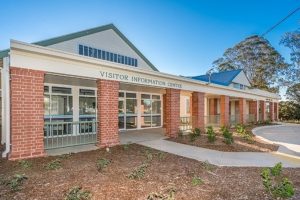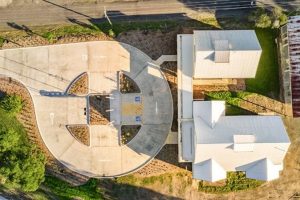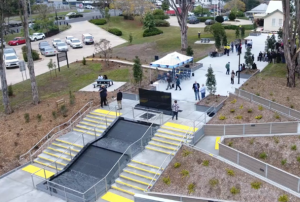The redevelopment of the Casino Drill Hall site has created an iconic new leisure and tourism space which defines the entry to Casino from the south.
The Casino Drill Hall Precinct was officially opened in September 2022. The $5.4 million redevelopment was made possible thanks to the Australian Government’s Building Better Regions Fund and Local Roads and Community Infrastructure Fund, where Council was successful in obtaining $2.7 million for the first stage, followed by $885,000 to build a memorial walk and a further $405,000 for much-needed upgrades at Coronation Park.
The project also received $252,000 from the NSW Government’s ClubGRANTS scheme, which helped fund the construction of the Casino Visitor Information Centre, and a $1.2 million contribution from Richmond Valley Council.
Opened in 2019, the first stage included the restoration and expansion of the Drill Hall proper, now home to the Visitor Information Centre and the Northern Rivers Military Museum, creating an important site for community events with the nearby amphitheatre, and added much-needed parking and landscaping.
This final stage has completed the project by adding the memorial walk, reflection pool and beautiful granite monument, which will stand alone as a major feature of the site, while also integrating the Drill Hall with the newly completed Coronation Park.
The unique poppy-themed playground at Coronation Park is complemented by a shaded picnic and BBQ area, new landscaping, boardwalk and a viewing platform set above the banks of the Richmond River.
In developing a theme for the proposed playground, the master plan took into consideration the history and use of the surrounding site, hence the use of the poppy, which is a powerful symbol of war remembrance.
The poppy-themed playground is the first of its kind, having been designed especially for this site and its important links to our Anzac history.
The fully completed Drill Hall and visitor information centre with surrounding open spaces and parkland will be a local-scale contemporary event and exhibition space with a focus on supporting cultural and community events for Casino and the Northern Rivers. It will also have a key role in supporting the region’s tourist industry and as a repository for the military history of Casino. Council will continue to seek further grant opportunities to realise the full scope of the project.





Project background and masterplan
The Drill Hall was originally built by the Light Horse Brigade in 1908 on land near the Post Office in Barker Street, before being relocated in the mid 1930s to its current location on sloping land to the south of the Richmond River on the Summerland Way.
Light Horse regiments from Casino, Tenterfield and Kyogle were based at Casino and used the hall for training. Following a severe outbreak of ‘flu in 1929 the Drill Hall was approved as an emergency hospital if required.
Council bought the land from the Department of Defence for $340,000 in 2015. Under the Commonwealth property disposals policy, there is a capacity for the Australian Government to sell surplus property to local government where such a sale would provide local economic or social benefits.
Council engaged architects Chris Pritchett and Associates to prepare a draft master plan for the development of the site, using information compiled from community meetings and feedback. The plan was endorsed by Richmond Valley Council in March 2017 and:
- Provides a strategic framework for the future enhancement and/or development of the site which recognises the resources available to Council and the community.
- Identifies issues involved with the site and presents plans to resolve or mitigate these issues.
- Introduces new activities and makes best use of the land available through maximising use of the site.
- Enhances the visitor and users’ experience
The Casino Drill Hall is the key building on the site and is the anchor around which the master plan was developed. The building has heritage recognition under the Richmond Valley Council Local Environment Plan.
Above: An aerial view of the Drill Hall and new visitor information centre buildings.
The area for this master plan project covers 73-81 Lennox Street and a section of Coronation Park. The total site, including the section of Lennox Street and the service road to the east of the site, is approximately 2.11 ha. The Drill Hall site is approximately 1.28 ha.
As much as possible the master plan has responded to the results of community consultation, the site analysis, and the realities of Council’s and the community’s resources. Additionally, it has integrated existing features with new facility requirements. Outcomes include:
- A design which emphasises the Casino Drill Hall as the anchor of the site.
- Dedicated precincts which define spaces and use.
- Indoor and outdoor event spaces for a range of community and cultural events.
- A flexible, multi-purpose design which encourages sharing of resources.
- A supportive environment to involve the community and foster new associations.
The relocation of the Visitor Information Centre from its current position to the Casino Drill Hall is an important contribution to the vibrancy of the site. Where tourists would normally just stop to gather information and to use the toilet facilities, with the correct encouragement, these visitors will be tempted to stay longer and use more of the site’s facilities.
Above: The finished interior of the new visitor information centre.
The site is connected into the walking and cycle paths along the south side of the Richmond River, such as to Queen Elizabeth Park, and across the Richmond River Bridge to the CBD and residential areas on the north side of the river. For most people the site will be easily accessed either on or off-road.
The redevelopment of the site has involved a number of different trades, such as: aluminium windows, bricklayers and blocklayers, concrete, doors and frames, earthworks, electrical services, hydraulic services, joinery, landscaping, mechanical services, painting, plasterboard, pest control, reinforcement, roofing, structural steel, surveying, tactile indicators, tiling, timber trusses , and waterproofing.

Above: Early construction of the Visitor Information Centre (30 November 2018)
